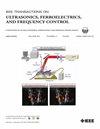PROTEUS:一个物理逼真的对比增强超声模拟器-第二部分:成像应用。
IF 3.7
2区 工程技术
Q1 ACOUSTICS
IEEE transactions on ultrasonics, ferroelectrics, and frequency control
Pub Date : 2025-03-12
DOI:10.1109/TUFFC.2025.3566437
引用次数: 0
摘要
在对比增强超声领域,由于难以控制实验室环境中复杂的实验变量,如血管几何形状、组织中的非线性超声波传播或血管内微泡位置作为时间的函数,阻碍了新成像范式的发展。这种发展将极大地受益于在模拟环境中独立控制和复制这些条件的能力。在这里,我们报告了一个物理上真实的对比度增强超声模拟器,PROTEUS,生成合成的对比度增强射频数据。在本研究的第二部分,我们展示了PROTEUS能够灵活地研究对比度增强超声成像参数,包括创新的换能器结构,如行列寻址阵列、微泡尺寸分布、脉冲序列和血管几何形状。我们演示了PROTEUS如何模拟各种2D和3D成像模式,如脉冲反转或幅度调制,回波粒子图像测速或超声定位显微镜。最后,在一个调查模拟案例研究中,我们评估了微泡大小分布对超声定位显微镜的影响,模拟了15000帧。它是作为科学界的开源工具发布的。本文章由计算机程序翻译,如有差异,请以英文原文为准。
PROTEUS: A Physically Realistic Contrast-Enhanced Ultrasound Simulator—Part II: Imaging Applications
The development of new imaging paradigms in the field of contrast-enhanced ultrasound (CEUS) is hindered by the difficulty to control complex experimental variables in a laboratory setting, such as vascular geometries, nonlinear ultrasound wave propagation in tissue, or microbubble positions within vessels as a function of time. This development would greatly benefit from the ability to control and reproduce independently these conditions in a simulated environment. Here, we report a physically realistic CEUS simulator, PROTEUS, that generates synthetic contrast-enhanced radio frequency (RF) data. In this article, we show that PROTEUS enables flexible investigations of imaging parameters on CEUS, including innovative transducer architecture, such as row-column addressed arrays, microbubble size distribution, pulse sequences, and vascular geometry. We demonstrate how PROTEUS can emulate various 2-D and 3-D imaging modes, such as pulse inversion (PI) or amplitude modulation (AM), echo particle image velocimetry (PIV), or ultrasound localization microscopy (ULM). Finally, in an investigative simulation case study, we evaluate the impact of microbubble size distribution on ULM on a simulated set of 15000 frames. It is released as an open-source tool for the scientific community.
求助全文
通过发布文献求助,成功后即可免费获取论文全文。
去求助
来源期刊
CiteScore
7.70
自引率
16.70%
发文量
583
审稿时长
4.5 months
期刊介绍:
IEEE Transactions on Ultrasonics, Ferroelectrics and Frequency Control includes the theory, technology, materials, and applications relating to: (1) the generation, transmission, and detection of ultrasonic waves and related phenomena; (2) medical ultrasound, including hyperthermia, bioeffects, tissue characterization and imaging; (3) ferroelectric, piezoelectric, and piezomagnetic materials, including crystals, polycrystalline solids, films, polymers, and composites; (4) frequency control, timing and time distribution, including crystal oscillators and other means of classical frequency control, and atomic, molecular and laser frequency control standards. Areas of interest range from fundamental studies to the design and/or applications of devices and systems.

 求助内容:
求助内容: 应助结果提醒方式:
应助结果提醒方式:


